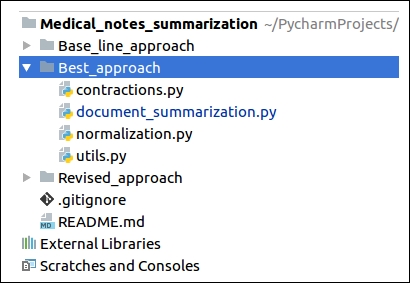In this section, we will look at the implementation of the best approach. We will also discuss the structure of the code. So, without wasting time, let's begin with the implementation. You can find the code by using this GitHub link: https://github.com/jalajthanaki/medical_notes_extractive_summarization/tree/master/Best_approach.
The steps you need to take in order to implement the code are provided in the following list:
Understanding the structure of the project
Understanding helper functions
Generating the summary
Let's start with the first step.
The structure of the project is quite important here. There will be four different files in which we will be writing code. You can see the structure of the project in the following figure:

Figure 7.15: Structure of the project's code files
There are four code files. I will explain their usage one by one:



